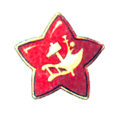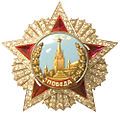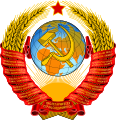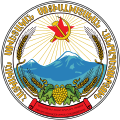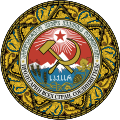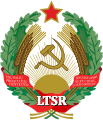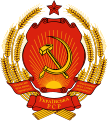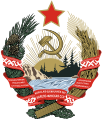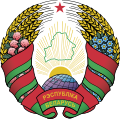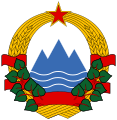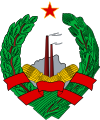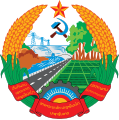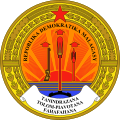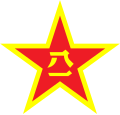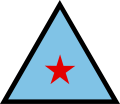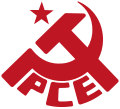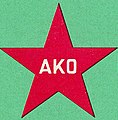
The State Flag of the Union of Soviet Socialist Republics, or simply the Soviet flag, was a red banner with two communist symbols displayed in the canton: a gold hammer and sickle topped off by a red five-point star bordered in gold. The flag's design and symbolism are derived from several sources, but emerged during the Russian Revolution. It has also come to serve as the standard symbol representing communism as a whole, recognized as such in international circles, even after the dissolution of the Soviet Union in 1991.

The hammer and sickle is a communist symbol representing proletarian solidarity between agricultural and industrial workers. It was first adopted during the Russian Revolution at the end of World War I, the hammer representing workers and the sickle representing the peasants.

In politics, a red flag is predominantly a symbol of left-wing politics, including socialism, communism, Marxism, labour movement, and anarchism. The originally empty or plain red flag has been associated with left-wing politics since the French Revolution (1789–1799).

The flag of Bosnia and Herzegovina contains a medium blue field with a yellow right triangle separating said field, and there are seven full five-pointed white stars and two half stars top and bottom along the hypotenuse of the triangle.

The national emblem of Belarus features a ribbon in the colors of the national flag, a silhouette of Belarus, wheat ears and a red star. It is sometimes referred to as the coat of arms of Belarus, although in heraldic terms this is inaccurate as the emblem does not respect the rules of conventional heraldry. The emblem is an allusion to one that was used by the Byelorussian SSR, designed by Ivan Dubasov in 1950, with the biggest change being a replacement of the Communist hammer and sickle with a silhouette of Belarus. The Belarusian name is Dziaržaŭny hierb Respubliki Biełaruś, and the name in Russian is Gosudarstvennyĭ gerb Respubliki Belarusʹ.

The coat of arms of Bosnia and Herzegovina was adopted in 1998, replacing the previous design that had been in use since 1992 when Bosnia and Herzegovina gained independence. It follows the design of the national flag. The three-pointed shield is used to symbolize the three major ethnic groups of Bosnia, as well as allude to the shape of the country.
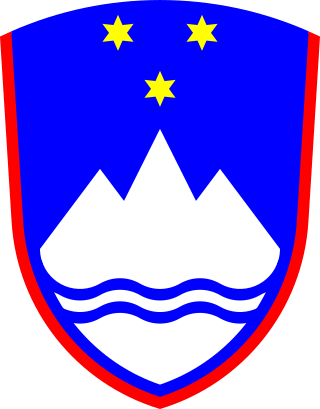
The Slovene coat of arms is an emblem that consists of a red bordered blue shield on which there is a stylised white Mount Triglav, under which there are two wavy lines representing the sea and the rivers of the country. Above Mount Triglav, there are three golden six-pointed stars representing the Counts of Celje. It was designed in 1991 by Marko Pogačnik and adopted on 24 June 1991.
The flags of the Soviet Socialist Republics were all defaced versions of the flag of the Soviet Union, which featured a golden hammer and sickle and a gold-bordered red star on a red field.

The emblems of the constituent republics of the Union of Soviet Socialist Republics all featured predominantly the hammer and sickle and the red star that symbolized communism, as well as a rising sun, surrounded by a wreath of wheat. The USSR State motto, Workers of the world, unite!, in both the republic's language and Russian was also placed on each one of them. In addition to those repetitive motifs, emblems of many Soviet republics also included features that were characteristic of their local landscapes, economies or cultures.

The state emblem of Uzbekistan was formally adopted on July 2, 1992, by the newly establish Republic of Uzbekistan. It bears many similarities to the emblem of the previous Uzbek Soviet Socialist Republic (SSR), which Republic of Uzbekistan succeeded. Like other post-Soviet republics whose symbols do not predate the October Revolution, the current emblem retains some components of the Soviet one. Prior to 1992, Uzbekistan had an emblem similar to all other Soviet Republics, with standard communist emblems and insignia.

A five-pointed star (☆), geometrically an equilateral concave decagon, is a common ideogram in modern culture. Comparatively rare in classical heraldry, it was notably introduced for the flag of the United States in the Flag Act of 1777 and since has become widely used in flags.

The Byelorussian SSR emblem was used as the coat of arms of the Soviet Socialist Republic until the fall of the Soviet Union. The coat of arms is based on the coat of arms of the Soviet Union.

The coat of arms of the Kirghiz Soviet Socialist Republic was adopted on March 23, 1937, by the government of the Kirghiz Soviet Socialist Republic. The coat of arms is based on the coat of arms of the Soviet Union. It shows symbols of agriculture on a backdrop of the Ala-Too mountain ranges, surrounded by a frame of folk art of the Kyrgyz people. The red star was added in 1948. The rising sun stands for the future of the Kyrgyz nation, the star as well as the hammer and sickle for the victory of communism and the "worldwide socialist community of states".

The State Emblem of the Tajik Soviet Socialist Republic was adopted on March 1, 1937 by the government of the Tajik Soviet Socialist Republic. The emblem is based on the State Emblem of the Soviet Union. It shows symbols of agriculture. The red star is prominently featured with a small hammer and sickle within it. The rising sun stands for the future of the Tajik nation, and the star as well as the hammer and sickle for the victory of communism and the "world-wide socialist community of states". The emblem was replaced with the new emblem in 1992, which uses a similar design to the Soviet one. It was, however, was replacing the red banner with the current national flag, the big red star was replaced by the mountains, represents Pamir, the Samanid dynasty crown, and added the Quran book at below. It represents Islam as the official religion.

The coat of arms of the Moldavian Soviet Socialist Republic was adopted on 10 February 1941 by the government of the Moldavian Soviet Socialist Republic. The coat of arms is based on the coat of arms of the Soviet Union. It shows symbols of agriculture, an outer rim featuring wheat, corn, grapes and clover. The red banner bears the Soviet Union state motto in both the Romanian language and the Russian language. In Romanian, it was initially "Пролетарь дин тоате цэриле, униць-вэ!"; then, from the 1950s "Пролетарь дин тоате цэриле, уници-вэ!". Both are written in the Latin alphabet as "Proletari din toate țările, uniți-vă!". The acronym MSSR is shown only in Romanian in Moldovan Cyrillic ("РССМ"). The emblem was replaced on 3 November 1990 by the present coat of arms of Moldova. Currently, the unrecognized breakaway state of Transnistria uses a similar state emblem.
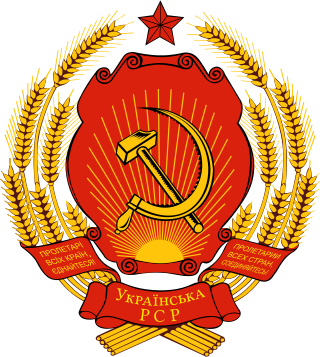
The coat of arms of the Ukrainian Soviet Socialist Republic was adopted on 14 March 1919 by the government of the Ukrainian Soviet Socialist Republic and subsequently modified on 7 November 1928, 30 January 1937 and 21 November 1949. The coat of arms from 1949 is based on the coat of arms of the Soviet Union and features the hammer and sickle, the red star, a sunrise and stalks of wheat on its outer rims. The rising sun stands for the future of the Soviet Ukrainian nation, the red star as well as the hammer and sickle for communism and the "world-wide socialist community of states".

Socialist-style emblems usually follow a unique style consisting of communist symbolism. Although commonly referred to as coats of arms, most are not actually traditional heraldic achievements. Many communist governments purposely diverged from heraldic tradition in order to distance themselves from the monarchies that they usually replaced, with coats of arms being seen as symbols of the monarchs.

The national emblem of North Macedonia depicts two curved garlands of sheaves of wheat, tobacco leaves and opium poppy fruits, tied by a ribbon decorated with embroidery of traditional Macedonian folk motifs. In the center of the ovoid frame are depicted a mountain, a lake and a sunrise. The features of the national coat of arms contain a rising sun which symbolizes freedom, the Šar Mountains with its peak named Ljuboten or Mount Korab and the river Vardar, with Lake Ohrid. The emblem also contains opium poppy fruits; this poppy was brought to the area during Ottoman times in the first half of the 19th century. Until 16 November 2009, the emblem also depicted a socialistic five-pointed star in the top. This emblem had been in use since 1946, shortly after the republic became part of Yugoslavia.
Communist symbolism represents a variety of themes, including revolution, the proletariat, the peasantry, agriculture, or international solidarity. The red flag, the hammer and sickle and the red star or variations thereof are some of the symbols adopted by communist movements, governments, and parties worldwide.

Communist symbols have been banned, in part or in whole, by a number of the world's countries. As part of a broader process of decommunization, these bans have mostly been proposed or implemented in countries that belonged to the Eastern Bloc during the Cold War, including some post-Soviet states. In some countries, the bans also extend to prohibit the propagation of communism in any form, with varying punishments applied to violators. Though the bans imposed by these countries nominally target the communist ideology, they may be accompanied by popular anti-leftist sentiment and therefore a de facto ban on all leftist philosophies, such as socialism, while not explicitly passing legislation to ban them.




